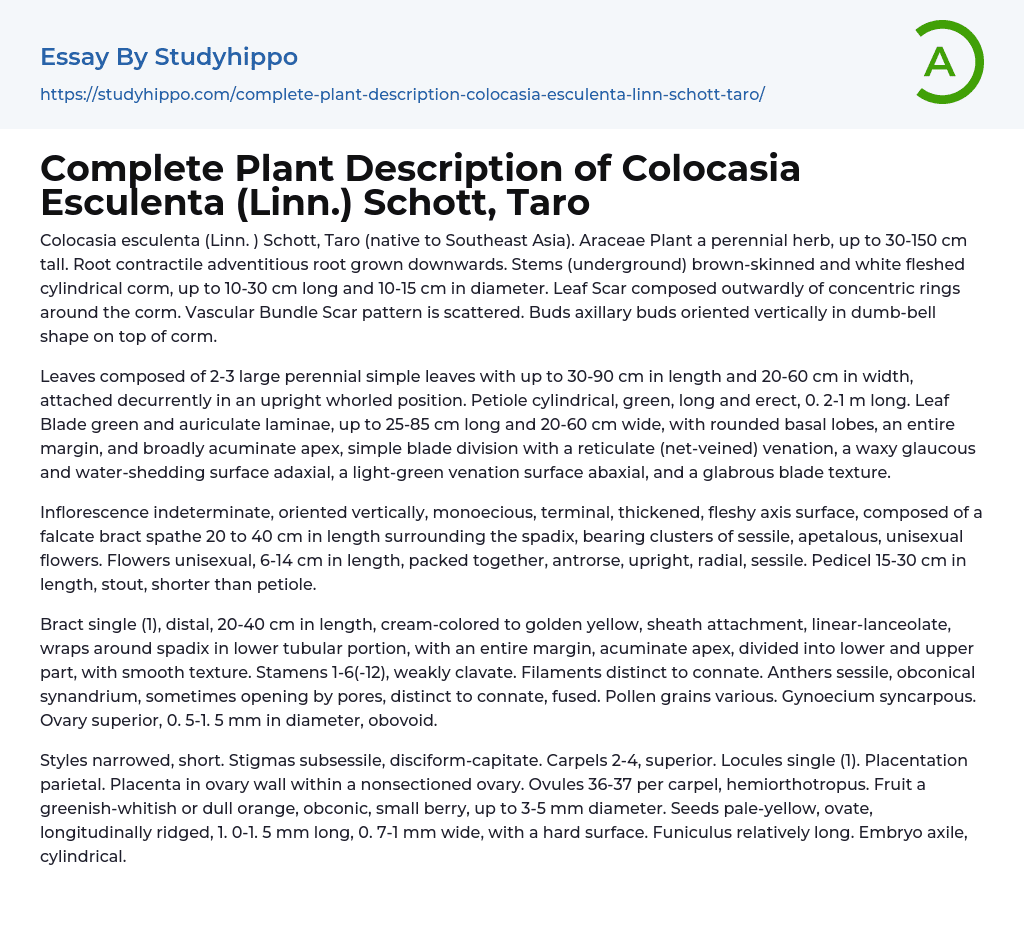

Complete Plant Description of Colocasia Esculenta (Linn.) Schott, Taro Essay Example
Colocasia esculenta (Linn.)
Schott, Taro, a perennial herb native to Southeast Asia, belongs to the Araceae plant family. It can grow up to 30-150 cm in height. The root of this plant has downward-growing contractile adventitious roots. The underground stems have brown skin and white flesh and are cylindrical corms that measure 10-30 cm in length with a diameter of 10-15 cm. Concentric rings surround the corm's leaf scar.
The Vascular Bundle Scar pattern is scattered. The buds are axillary buds that are oriented vertically in a dumb-bell shape on top of the corm. The leaves are composed of 2-3 large perennial simple leaves. They can reach up to 30-90 cm in length and 20-60 cm in width. The leaves are attached decurrently in an upright whorled position. The petiole is cylindrical and green, with a long and erect s
...hape, reaching 0.2-1 m in length. The Leaf Blade is green and auriculate laminae, with a length of up to 25-85 cm and a width of 20-60 cm. It has rounded basal lobes, an entire margin, and a broadly acuminate apex. The blade is simple, with a reticulate (net-veined) venation. The adaxial surface is waxy glaucous and water-shedding, while the abaxial surface is light-green venation. The blade texture is glabrous.
The inflorescence of the plant is indeterminate and vertically oriented. It is monoecious and terminal, with a thickened, fleshy axis surface. It is composed of a falcate bract spathe that is 20 to 40 cm long and surrounds the spadix. The spadix bears clusters of sessile, apetalous, and unisexual flowers. These flowers are unisexual and range in length from 6 to 14 cm. They are packed together, antrorse, upright
radial, and sessile. The pedicel is stout and 15 to 30 cm long, shorter than the petiole. There is a single distal bract that is 20 to 40 cm long. It is cream-colored to golden yellow and attached to the sheath. The bract is linear-lanceolate in shape and wraps around the lower tubular portion of the spadix. It has an entire margin, an acuminate apex, and is divided into lower and upper parts. The texture of the bract is smooth.
The stamens are weakly clavate, numbering from 1 to 6 (or sometimes up to 12). The filaments can be separate or fused together. The anthers are sessile and form an obconical synandrium, which may open by pores or be fused. The pollen grains exhibit a range of characteristics.
The syncarpous gynoecium has a superior ovary that is obovoid and measures 0.5-1.5 mm in diameter. The styles are short and narrowed.
The stigma is subsessile and disciform-capitate. There are 2-4 superior carpels. The locules are single. The placentation is parietal, with the placenta located within a nonsectioned ovary wall. There are 36-37 ovules per carpel, and they are hemiorthotropus.
The fruit is a small obconic berry, measuring up to 3-5 mm in diameter. It can be either greenish-whitish or dull orange. The seeds are ovate and pale-yellow, with longitudinal ridges. They are approximately 1.0-1.5 mm long and 0.
The width of the text is 7-1 mm with a hard surface. The funiculus is relatively long. The embryo is axile and cylindrical.
- Tree essays
- Seed essays
- Bacteria essays
- Biotechnology essays
- Breeding essays
- Cell essays
- Cell Membrane essays
- Cystic Fibrosis essays
- Enzyme essays
- Human essays
- Microbiology essays
- Natural Selection essays
- Photosynthesis essays
- Plant essays
- Protein essays
- Stem Cell essays
- Viruses essays
- John Locke essays
- 9/11 essays
- A Good Teacher essays
- A Healthy Diet essays
- A Modest Proposal essays
- A&P essays
- Academic Achievement essays
- Achievement essays
- Achieving goals essays
- Admission essays
- Advantages And Disadvantages Of Internet essays
- Alcoholic drinks essays
- Ammonia essays
- Analytical essays
- Ancient Olympic Games essays
- APA essays
- Arabian Peninsula essays
- Argument essays
- Argumentative essays
- Art essays
- Atlantic Ocean essays
- Auto-ethnography essays
- Autobiography essays
- Ballad essays
- Batman essays
- Binge Eating essays
- Black Power Movement essays
- Blogger essays
- Body Mass Index essays
- Book I Want a Wife essays
- Boycott essays
- Breastfeeding essays
- Bulimia Nervosa essays



